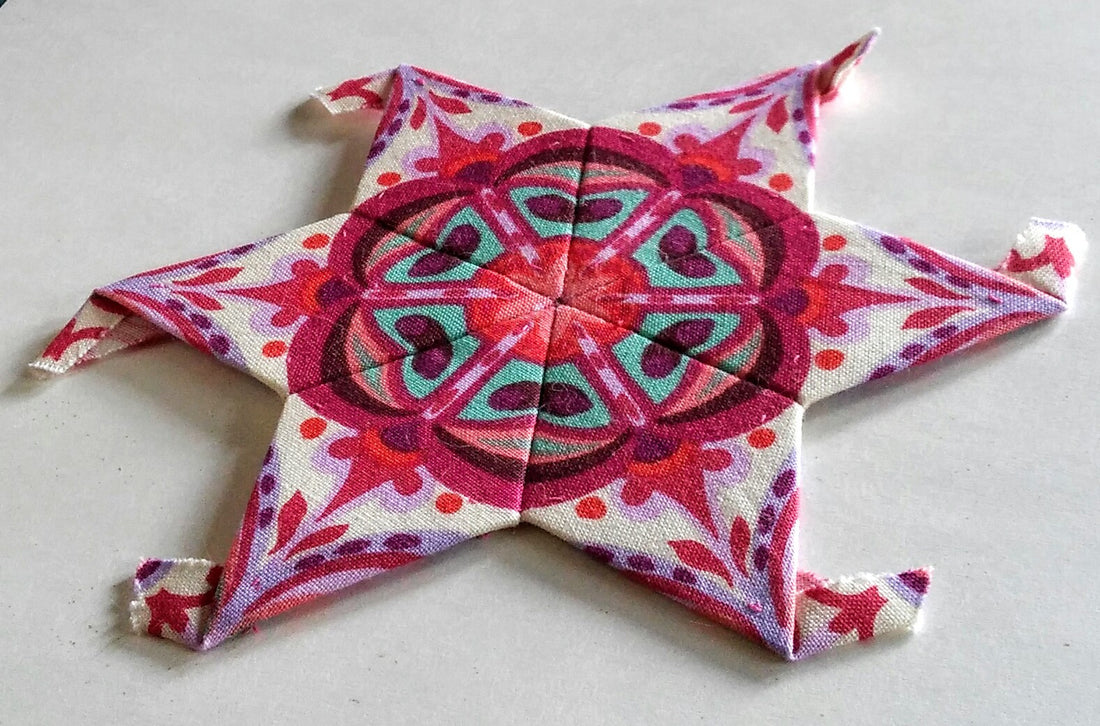
Fussy Cutting Tutorial
Share

Fussy Cutting Complex Designs for EPP by Carolyn Pytlik
Fussy cutting fabric for English Paper Piecing (EPP) can simply be cutting pretty motifs or can involve creating whole new designs with adjoining pieces. This article outlines my method for the latter.
There are numerous methods and hints for English Paper Piecing. My methods are not fast, but I believe they can give you magnificent results. Maybe this article will send you on a whole new adventure or maybe you will simply gain a hint or two to help you along the way. Always remember to have fun!
First, Basic Supplies:
- An acrylic cutting template with a 3/8" seam allowance. The 3/8" seam gives you a little wiggle room.
- A fussy cut viewer, available in a variety of products. I cut mine from plain white cardstock by tracing the paper piece to be used onto the cardstock and carefully cutting it out.
- Paper pieces.
- A marking tool. My favorite is a Sewline fine mechanical pencil.
- A sandpaper board behind the fabric will keep it from shifting.
- Small wonder clips for holding the fabric to the paper pieces when basting.
- Needle and thread for basting fabric to the paper pieces and later for adjoining pieces. Glue basting is an option; it is quicker. To get the results I am seeking, I may reposition my fabric numerous times; thread basting makes this easy for me. And, I really enjoy the basting process.
- Sharp scissors. I prefer Karen Kay Buckley light blue six-inch scissors for the serrated edge which grabs the fabric and her small green scissors for snipping threads.
- A Magic Mirror is a great help for viewing. It is important to remember that a mirror gives you a reverse image.

The next picture reveals 6-pointed stars, each with a complex fussy cutting motif creating an adjoining design. This is easiest to do when the motif is symmetrical.

When making my first cut for a complex design, I place my fussy cutting viewer in position and make tiny registration marks at two or three points. I remove the viewer and line up my acrylic cutting template to those marks. I trace around the template, then cut exactly on the tracing line. For additional identical cuts, I line up my first cut fabric shape in an identical position on the fabric, both right sides up. I place the acrylic template on top and draw around that shape, then cut. I continue using the first cut piece as a guide. I cut every piece individually.

When basting, I like to make light pencil marks on the back of my paper pieces to line up my fabric. Wonder clips will hold the fabric in place before basting. At this point, you can turn the piece to the front to see if the placement is exact. Don't be surprised if this takes a few attempts. I baste with my long stitches on the back for two reasons. First, for photographing so that the threads don't show on the front. Second, the long stretch of thread on the back holds the folded edge of the fabric in place better.

Once all pieces are basted to my satisfaction, I use thin milliners needles and a strong cotton thread to whip stitch pieces together with very small close stitches. I often start my stitching at a critical matching point, even though this requires knotting off more than once in a seam. I have a pair of very fine pointed embroidery scissors to pick out threads when I'm not satisfied, and I use those quite often.
With a little practice and patience, you can achieve magnificent results. And when you go to the fabric store or sort through your stash, you will look at fabric with a whole new perspective.
About Carolyn Pytlik

(Pictured above blocks made by Carolyn from Visible Light by Melissa Peda)
Carolyn Pytlik has been sewing since she was a child. In addition to English Paper Piecing, she likes needle turn appliqué, embroidery, counted cross stitch, fabric and cats. You can see some of her projects in progress on Instagram @cheshire_cat_quilts.
